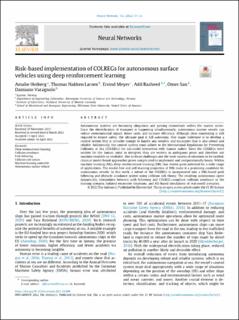| dc.contributor.author | Heiberg, Amalie | |
| dc.contributor.author | Larsen, Thomas Nakken | |
| dc.contributor.author | Meyer, Eivind | |
| dc.contributor.author | Rasheed, Adil | |
| dc.contributor.author | San, Omer | |
| dc.contributor.author | Varagnolo, Damiano | |
| dc.date.accessioned | 2023-02-16T12:13:42Z | |
| dc.date.available | 2023-02-16T12:13:42Z | |
| dc.date.created | 2021-12-20T02:16:05Z | |
| dc.date.issued | 2022 | |
| dc.identifier.citation | Neural Networks. 2022, 152 17-33. | en_US |
| dc.identifier.issn | 0893-6080 | |
| dc.identifier.uri | https://hdl.handle.net/11250/3051483 | |
| dc.description.abstract | Autonomous systems are becoming ubiquitous and gaining momentum within the marine sector. Since the electrification of transport is happening simultaneously, autonomous marine vessels can reduce environmental impact, lower costs, and increase efficiency. Although close monitoring is still required to ensure safety, the ultimate goal is full autonomy. One major milestone is to develop a control system that is versatile enough to handle any weather and encounter that is also robust and reliable. Additionally, the control system must adhere to the International Regulations for Preventing Collisions at Sea (COLREGs) for successful interaction with human sailors. Since the COLREGs were written for the human mind to interpret, they are written in ambiguous prose and therefore not machine-readable or verifiable. Due to these challenges and the wide variety of situations to be tackled, classical model-based approaches prove complicated to implement and computationally heavy. Within machine learning (ML), deep reinforcement learning (DRL) has shown great potential for a wide range of applications. The model-free and self-learning properties of DRL make it a promising candidate for autonomous vessels. In this work, a subset of the COLREGs is incorporated into a DRL-based path following and obstacle avoidance system using collision risk theory. The resulting autonomous agent dynamically interpolates between path following and COLREG-compliant collision avoidance in the training scenario, isolated encounter situations, and AIS-based simulations of real-world scenarios. | en_US |
| dc.language.iso | eng | en_US |
| dc.publisher | Elsevier Ltd. | en_US |
| dc.rights | Navngivelse 4.0 Internasjonal | * |
| dc.rights.uri | http://creativecommons.org/licenses/by/4.0/deed.no | * |
| dc.title | Risk-based implementation of COLREGs for autonomous surface vehicles using deep reinforcement learning | en_US |
| dc.title.alternative | Risk-based implementation of COLREGs for autonomous surface vehicles using deep reinforcement learning | en_US |
| dc.type | Peer reviewed | en_US |
| dc.type | Journal article | en_US |
| dc.description.version | publishedVersion | en_US |
| dc.source.pagenumber | 17-33 | en_US |
| dc.source.volume | 152 | en_US |
| dc.source.journal | Neural Networks | en_US |
| dc.identifier.doi | 10.1016/j.neunet.2022.04.008 | |
| dc.identifier.cristin | 1970326 | |
| dc.relation.project | Norges forskningsråd: 295033 | en_US |
| cristin.ispublished | true | |
| cristin.fulltext | original | |
| cristin.qualitycode | 2 | |

